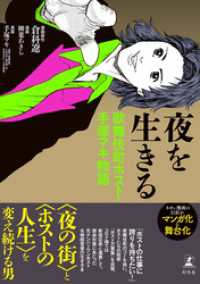- ホーム
- > 洋書
- > 英文書
- > History / World
Full Description
The nineteenth century in the United States witnessed the end of slavery and the expansion of another form of confinement: the asylum. How did enslaved and free Black people encounter psychiatric institutions? How were notions of mental disability used to reinforce slavery and Jim Crow? And how did Black people express alternative ideas about individual and communal mental health?
Diana Martha Louis explores Black experiences and views of mental disability in the nineteenth century, shedding light on the lives and struggles of the "colored insane." She demonstrates how psychiatric discourses made Blacks "mad" both by inflicting real psychological harm within asylums, plantations, jails, and society writ large and by constructing mental disorders according to prevailing notions of race, class, gender, and sanity. Yet even as white medical professionals pathologized the enslaved as suffering from "drapetomania" (runaway slave syndrome), portrayed slavery as beneficial to Black mental health, or cast African-derived spiritual beliefs and practices as signs of madness, Black people developed their own complex perspectives on mental disability.
Louis considers the lives and writings of Black intellectuals and cultural figures including James McCune Smith, Harriet Jacobs, Harriet Tubman, and Charles Chesnutt, as well as a group of Black women who were incarcerated in Georgia Lunatic Asylum, showing how mental disability was entangled with questions of freedom, spirituality, and self-determination. Combining literary and historical analysis, Colored Insane is a rich account of nineteenth-century Black Americans' experiences of mental illness and wellness.
Contents
Introduction
1. Antebellum Psychiatric and Medical Discourses on the Black Bodymind
2. Mental Disability and the Intellectual Thought of James McCune Smith
3. Psychological Costs of Black Women's Enslavement in Harriet Jacobs's Incidents in the Life of a Slave Girl (1861)
4. Harriet Tubman and Nineteenth-Century Conceptions of Mental Disability
5. Black Women's Psychiatric Incarceration at Georgia Lunatic Asylum in the Nineteenth Century
6. Charles Chesnutt and Mental Disability in the Age of Black Freedom
Coda
Acknowledgments
Notes
Bibliography
Index








